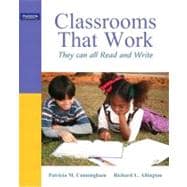
Note: Supplemental materials are not guaranteed with Rental or Used book purchases.
Purchase Benefits
What is included with this book?
| Preface | p. ix |
| Creating Classrooms That Work | p. 1 |
| Observing in the Classrooms of Unusually Effective Teachers | p. 2 |
| What We Know about Classrooms That Work | p. 8 |
| Creating Your Own Classroom That Works, Even Better | p. 11 |
| Creating Enthusiastic, Independent Readers | p. 12 |
| Assess and Document Your Students' Independent Reading | p. 13 |
| Make Teacher Read-Aloud an Everyday Event | p. 14 |
| Schedule Time Every Day for Independent Reading | p. 18 |
| Accumulate the Widest Possible Variety of Reading Materials | p. 20 |
| Schedule Conferences So You Can Talk with Your Students about Their Reading | p. 22 |
| Make Time for Sharing and Responding | p. 24 |
| Summary | p. 27 |
| Building the Literacy Foundation | p. 28 |
| Concepts That Form the Foundation for Literacy | p. 30 |
| Activities for Building the Foundation | p. 34 |
| Summary | p. 47 |
| Fostering Fluency | p. 48 |
| Mandate Easy Reading for Everyone | p. 50 |
| Model Fluent, Expressive Reading | p. 53 |
| Provide Engaging Rereading Opportunities | p. 57 |
| Use a Word Wall to Teach High-Frequency Words | p. 59 |
| Summary | p. 63 |
| Teaching Phonics and Spelling Patterns | p. 65 |
| Guess the Covered Word | p. 68 |
| Using Words You Know | p. 71 |
| Making Words | p. 75 |
| The Nifty-Thrifty-Fifty | p. 87 |
| The Wheel | p. 91 |
| Summary | p. 92 |
| Building Vivid, Vital, and Valuable Vocabularies | p. 94 |
| How Do We Learn All the Words We Know? | p. 96 |
| Provide as Much Real Experience as Possible | p. 99 |
| Increase Meaning Vocabularies through Reading | p. 104 |
| Teach Morphemes, Context, and the Dictionary to Learn New Words | p. 108 |
| Teach Children to Monitor Their Vocabulary Knowledge | p. 112 |
| Promote Word Wonder | p. 114 |
| Summary | p. 115 |
| Developing Thoughtful Comprehenders | p. 117 |
| Comprehension Strategies | p. 120 |
| Literate Conversations | p. 121 |
| Think-Alouds | p. 126 |
| Informational Text Lessons | p. 132 |
| Story Text Lessons | p. 138 |
| Summary | p. 143 |
| Developing Ready, Willing, and Able Writers | p. 145 |
| Starting the Year with Writer's Workshop | p. 147 |
| Adding Editing to Writer's Workshop | p. 151 |
| Adding Conferencing, Publishing, and Author's Chair to Writer's Workshop | p. 156 |
| Adding Revising to Writer's Workshop | p. 160 |
| Focused Writing | p. 168 |
| Summary | p. 178 |
| Reading and Writing across the Curriculum | p. 180 |
| Use Shared Reading to Teach Your Students How to Read Informational Text | p. 181 |
| Help Your Students Transfer Their Comprehension Strategies When Reading Science and Social Studies | p. 184 |
| Spotlight Vocabulary in Science, Social Studies, and Math | p. 185 |
| Link Vocabulary Development to Comprehension Lessons | p. 186 |
| Writing to Learn | p. 193 |
| Think-Writes | p. 194 |
| Summary | p. 203 |
| Assessment | p. 204 |
| What Is Assessment? | p. 205 |
| Determining Student Reading Level | p. 205 |
| Identifying Good Literacy Behaviors and Documenting Student Progress | p. 209 |
| Summary | p. 217 |
| Differentiating Instruction for Diverse Learners | p. 218 |
| Use a Variety of Collaborative Groupings | p. 221 |
| Partner Older Struggling Readers to Tutor Younger Struggling Readers | p. 232 |
| Find and Train a Tutor for Your Most Needy Child | p. 233 |
| Coordinate with Reading and Other Specialists | p. 237 |
| Use the Latest Technology | p. 238 |
| Increase the Support You Are Providing Your English Language Learners | p. 240 |
| Summary | p. 241 |
| Inside Classrooms That Work | p. 243 |
| A Day in a Kindergarten Classroom | p. 244 |
| A Day in a Primary Classroom | p. 250 |
| A Day in an Intermediate Classroom | p. 259 |
| References | p. 267 |
| Index | p. 271 |
| Table of Contents provided by Ingram. All Rights Reserved. |
The New copy of this book will include any supplemental materials advertised. Please check the title of the book to determine if it should include any access cards, study guides, lab manuals, CDs, etc.
The Used, Rental and eBook copies of this book are not guaranteed to include any supplemental materials. Typically, only the book itself is included. This is true even if the title states it includes any access cards, study guides, lab manuals, CDs, etc.